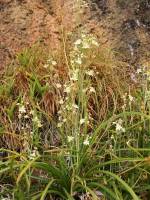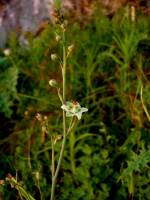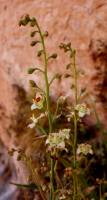|
|
|
|
Family: Melanthiaceae
mountain deathcamas, more...mountain deathcamas
[Zigadenus elegans Pursh, moreZigadenus elegans subsp. elegans] |
Plants 2-8 dm, from bulbs; bulbs not clumped, tunicate, narrowly ovoid, 1.5-3 × 1-2 cm. Stems without persistent leaf bases. Leaves: proximal blades 10-30 cm × 3-15 mm. Inflorescences loosely racemose to paniculate, 10-50-flowered, with 1-4 branches, 0.9-2.5 dm × 3-6 cm. Flowers: perianth perigynous, rotate to rotate-campanulate, 15-20 mm diam.; tepals persistent in fruit, cream colored to greenish, ovate, 7-12 × 4-5 mm, somewhat narrowed at base; gland 1, obcordate; pedicel erect at anthesis, 1-2.3 cm, bracts often tinged with purple or pink, ovate, 5-20 mm. Capsules narrowly conic, 10-20 mm. 2n = 32. Flowering Jun--Aug. Moist grasslands, river and lake shores, bogs in coniferous forests; 0--3600 m; Alta., B.C., Man., N.W.T., Ont., Que., Sask., Yukon; Alaska, Ariz., Colo., Idaho, Ill., Ind., Iowa, Md., Mich., Minn., Mo., Mont., Nebr., Nev., N.Mex., N.Y., N.C., N.Dak., Ohio, Oreg., Pa., S.Dak., Tenn., Tex., Utah, Vt., Va., Wash., W.Va., Wis., Wyo.; Mexico. Zigadenus elegans has been treated previously as comprising two varieties, or two subspecies (W. B. Zomlefer 1997b). The western var. or subsp. elegans tends to be a smaller plant with a raceme or a 1-2-branched panicle and glabrous, sometimes glaucous leaves and stems; while the eastern var. or subsp. glaucus tends to be a larger plant with a paniculate inflorescence and glaucous leaves and stems. Because there is considerable evidence of intergradation between the two entities toward the middle of the range, including overlapping flowering times, they have not been formally distinguished here.
Perennial herb with a bulb stem 20 cm - 0.8 m tall Leaves: alternate, usually fewer than ten, mostly basal, 10 - 40 cm long, 3 - 15 mm wide, reduced upward (and grading into floral bracts), linear, with a waxy coating (glaucous). Inflorescence: a terminal, branched cluster of ten to fifty flowers raised on an upright stalk, 10 - 30 cm long. Flowers: cream to greenish yellow, 1.5 - 2 cm wide, disc- to bell-shaped, with six tepals that persist in fruit. Tepals 7 - 12 mm long, 4 - 5 mm wide, egg-shaped with a somewhat narrowed base, sometimes with a green gland just below the middle. Flower stalk upright, 1 - 2.3 cm long, with two purple- or pink-tinged bracts. Stamens six. Fruit: a three-lobed capsule, 1 - 2 cm long, egg-shaped. Seeds angular. Similar species: No information at this time. Flowering: June to August Habitat and ecology: Very rare in the Chicago Region, where it grows in calcareous springy areas. Occurence in the Chicago region: native Etymology: Zigadenus means "yoked glands." Elegans means elegant. Author: The Morton Arboretum Stems erect, 2-6 dm from tunicated bulbs; herbage glaucous especially when young; lvs mostly crowded toward the base, linear, 2-4 dm, up to 12 mm wide; infl 1-3 dm, paniculate (seldom merely racemose), its branches subtended by large, lance-ovate bracts, these usually suffused with purple and marcescent at anthesis; tep 7-12 mm, oblong-obovate, rounded-obtuse, adnate at base to the ovary-base, white or greenish-yellow, usually strongly suffused with purple or brown toward the base beneath, and with a dark obcordate gland just below the middle on the upper side; fr ovoid, 10-15 mm; seeds angular, 3 mm; 2n=32. Beaches and bogs and other wet, often calcareous places; Que. to N.Y., w. across n. U.S. and adj. Can. to the cordilleran region from Alas. to n. Mex.; disjunct in the s. Appalachian region (Va. to N.C.) and in the Ozarks (Mo. and Ark.). July, Aug. Our plants, as here described, mostly belong to the e. var. glaucus (Nutt.) Preece, called white camas. Along our w. border, in Minn. and Io. var. glaucus passes into the more western, mainly cordilleran var. elegans, with yellower fls, less consistently glaucous herbage, and often merely racemose infl. (Anticlea e.) Gleason, Henry A. & Cronquist, Arthur J. 1991. Manual of vascular plants of northeastern United States and adjacent Canada. lxxv + 910 pp. ©The New York Botanical Garden. All rights reserved. Used by permission. Duration: Perennial Nativity: Native Lifeform: Forb/Herb General: Perennial, 15-80 cm tall; stems erect, simple, glabrous; bulbs narrowly ovoid. Leaves: Basal and cauline, linear, 25-45 cm long, 3-20 mm wide, the cauline blades often reduced, flat, margins entire, bases clasping. Flowers: Inflorescence a terminal, dense, showy panicle, 30-70 cm long, subtended by ovate-elliptic bracts, these often surpassing the branches in the lower part of the inflorescence; flowers campanulate, sessile or on short pedicels; tepals lanceolate, elliptic, or oblong-ovate, 8-17 mm long, white to greenish white, glabrous to tomentose on the outer surface, margins entire or minutely dentate; gland at the base of the tepal V- shaped, green; ovary glabrous or sparsely hairy; flowers July-August. Fruits: Loculicidal capsule, narrowly conic, 5-20 mm long; seeds 4-5 mm long, straw colored. Ecology: Moist meadows, rivers and lakeshores, pine forests; 1500- 3200 m (5000-10500 ft); Apache, Coconino, Gila, Greenlee, and Yavapai counties; northeastern, north-central, western Canada, northeastern, north-central, western, southwestern U.S. Notes: Zigadenus virescens (green death camas) is distinguished by its campanulate flowers, pedicels recurved at time of flowering, and tepals greenish, sometimes purple tinged. It has been reported only from the White Mountains in Apache County. All parts of mountain deathcamas are poisonous. Editor: Springer et al. 2008 |
|
|
|


.JPG)
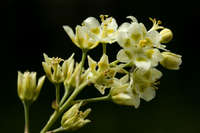
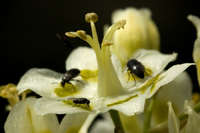
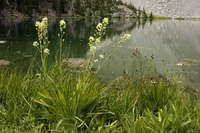

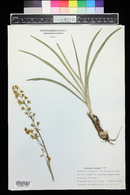
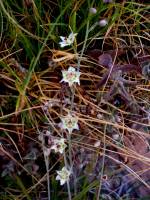
_tn.jpg)
